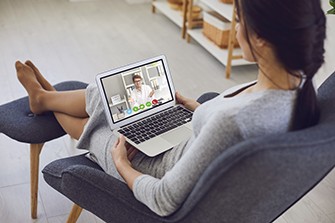Challenges of Telehealth During COVID-19
Over the past few weeks, the world has banded together in many ways. Whether it’s helping our neighbors, encouraging social distancing, or experimenting with virtual meetings, people are using unconventional methods to keep up with the needs of their daily lives. One virtual meeting that you may have come across is telehealth services. As beneficial as it is, telehealth does offer its own set of challenges. If you feel like you’re experiencing the challenges of telehealth during COVID-19, you are not alone. Keep reading to find out what they are and how you can continue using telehealth to your benefit.
Challenges of Telehealth During COVID-19: Tougher to Create a Relationship
An ideal situation is for you and your therapist to meet face-to-face and to only have phone or telehealth appointments during special circumstances. This is because being face-to-face offers the opportunity for a better bond and relationship between the patient and the therapist, which is essential to a successful recovery.
Your therapist may have a difficult time reading your body language to match the tone of your voice when you are both relying on telehealth-only appointments. In addition, you might struggle a little more to be completely open and honest in fear that someone else in the home might be listening in.
Telehealth Challenge: Distractions Can Interrupt Focus
Another challenge of telehealth during COVID-19 is that distractions can pop up more frequently at home, which can interrupt focus for both you and your therapist.
While you’re on your telehealth appointment, you might be intermittently staring at that pile of laundry in the corner and thinking about when you’ll be able to handle it. The baby might start crying, your phone might start ringing, the internet might cut out or freeze your frame, or someone might walk in the room and accidentally interrupt your conversation.
Therapists work hard to have a distraction-free environment in their office, which is why their office decorations are minimal and you’re required to place your phone on silent or turn it off to be able to completely focus on them.
Ways to Limit Distractions
- Put a “Do Not Disturb” sign on the outside of your door so that the rest of your family knows not to knock or walk in.
- Pick a spot to set up. It can be distracting for both you and your therapist if you’re walking around your home during the call or doing other things at the same time. Pick a spot, set up your laptop or phone there, and take your hands off of it.
- Once you know which room you’ll use, clean it up before your appointment so that nothing will catch your eye and nag at you while you’re on your call.
- Use your laptop instead of a cell phone during the video chat, if possible. Leave your phone in another room to limit your distractions. If you must use your phone, put your phone on Airplane Mode and leave the WiFi on so that you can still connect to your call. That way, no calls or texts will come in during that time with your therapist.
Telehealth Challenge: Increased Feelings of Isolation and Anxiety
Being able to connect with your therapist via virtual chat can be a double-edged sword for many people. While it is great to have access to the help you need, it can also increase feelings of isolation and anxiety. Seeing your therapist week after week on video can be a reminder of how long you’ve been secluded, which can cause anxiety.
A good tip for battling this challenge of telehealth during COVID-19 is that after you get off a call with your therapist, make sure you have a support group to chat with afterward. Sometimes, having a fun and lively chat with a group of people experiencing the same thing as you can help lift your spirits.
Telehealth Challenge: Learning Curve
As with any new activity, there is a learning curve with telehealth. Therapists need to learn how to make their patients feel happy and comfortable without physically being with them, and patients need to learn how to feel open and honest with their therapist while not being in their office.
In addition, technology isn’t everyone’s best friend. Some people are more adept at it than others. Troubles logging on, connecting to WiFi, and more issues can rise up. However, it is important to remember that – just like with any technology – the more you use it, the better you will get at it.
There can be many challenges of telehealth during COVID-19, however, none of them should become a barrier for your recovery. If you find yourself frequently missing appointments or that staying sober is becoming too overwhelming, contact us or another reputable recovery center. Cliffside Malibu is still open and available to help you through this uncertain time, and here to keep you on the right track.
About Cliffside Malibu
Because no two addictions are the same, we develop individualized treatment plans for every patient at Cliffside Malibu. We are committed to providing evidence-based treatment through a continuum of care model across a range of levels of care, including medically supervised detox, residential treatment, day treatment, and outpatient services. Our program includes family therapy and holistic therapy. Whether an individual has a substance abuse and/or alcohol addiction, our programs are structured to create a supportive environment where healing can begin.
In addition to world-class treatment, Cliffside Malibu offers luxury accommodations, a serene environment, five-star dining, and plentiful amenities. We understand that addiction treatment is a rigorous process. Therefore, we provide for your comfort and relaxation at every turn, allowing you to rejuvenate, and meet the demands of treatment with your greatest energy and attention.
For more information, visit Cliffside Malibu.
